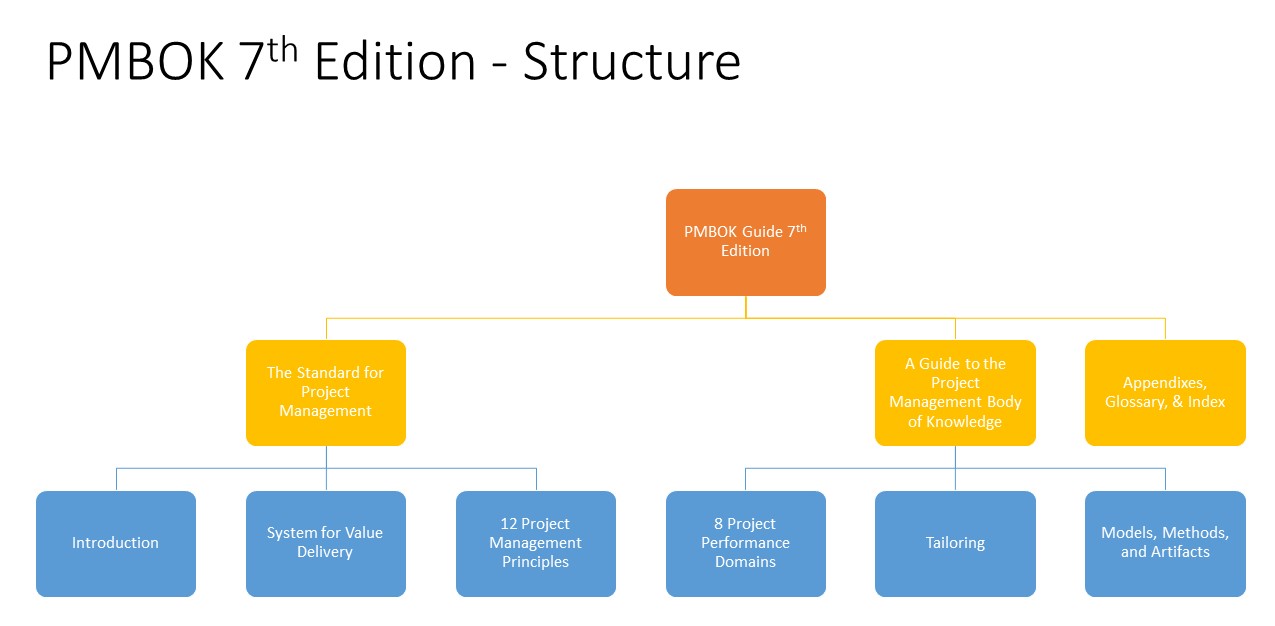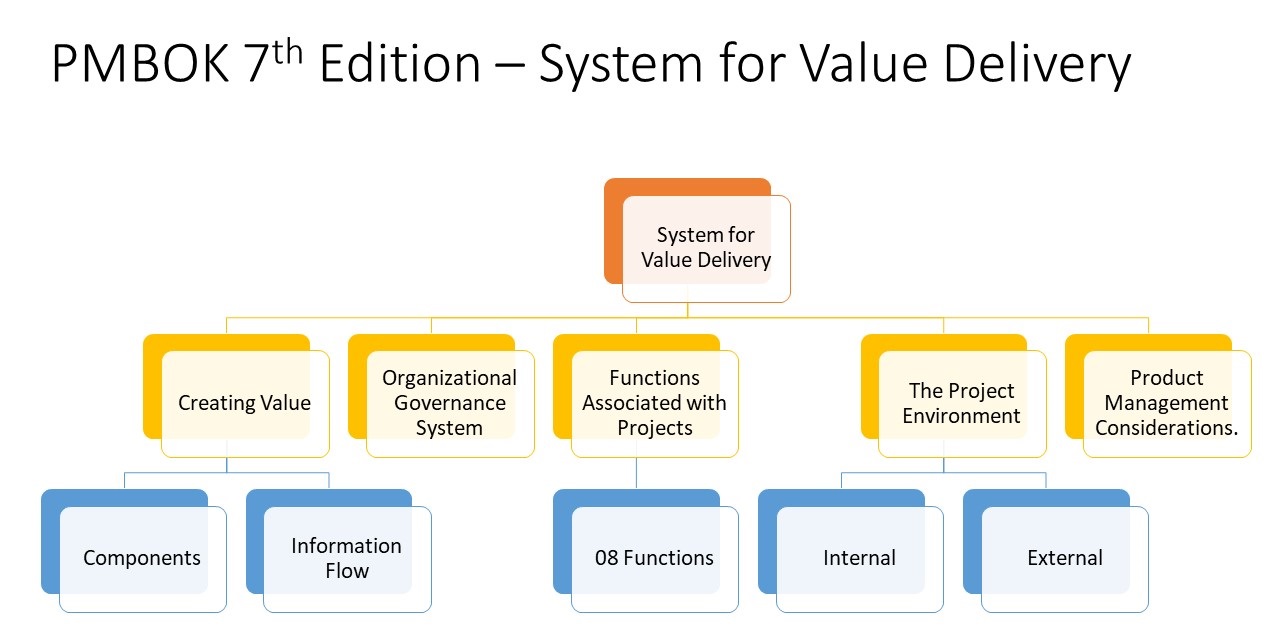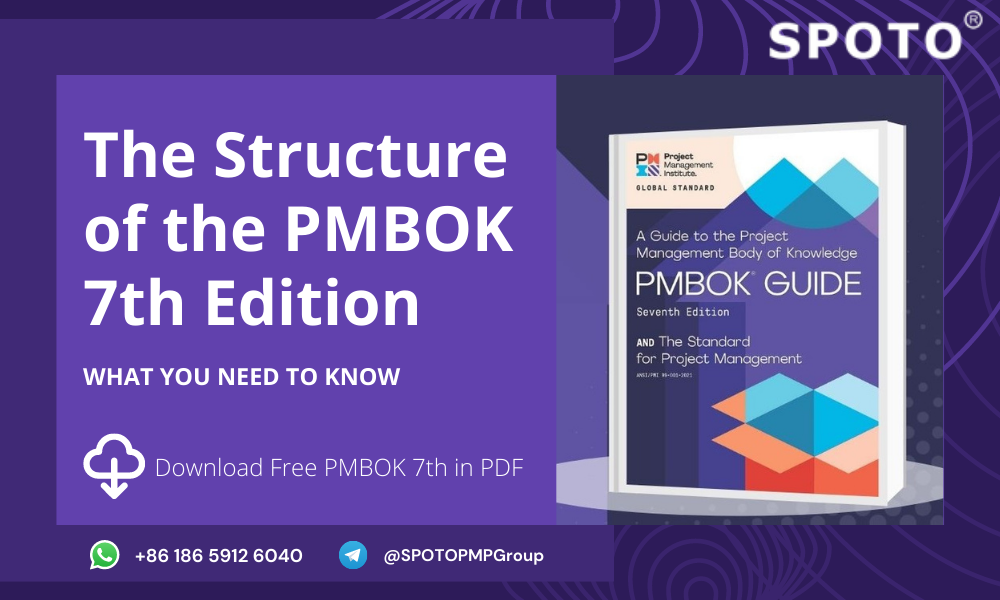PMBOK 7th is currently accessible to download from all PMI paying members active on the PMI website before launch. It is a 370-page book that does not replace the thorough PMBOK 6th Edition (794 pages). Rather than that, it brings another perspective and value to project management. As a result, all PMI tests are still based on the PMBOK 6th Edition.
Contact us to download the Free PMBOK 7th and PMBOK 6th PDF.
To clarify, our recent article discusses frequently asked questions about the PMBOK 7th edition. However, the focus of this blog article is on the new PMBOK 7th edition’s initial impressions.
The Structure of the PMBOK Guide 7th Edition
First, compared to the previous edition, it is a relief to see the new standard come in just 370 pages. Colored graphics have also been added to the latest version, making reading a little more interesting. The overall structure of the guide has changed significantly, in addition to the visual modifications.
The most crucial aspect to remember is that the PMBOK seventh edition is separated into two parts: a project management standard and a guide to the project management body of knowledge.
Furthermore, the project management standard and the PMBOK Guide in the PMBOK 7th edition contain different content. As a result, it’s critical to read the entire guide.

Further Reading:
Top 8 FAQs about the PMBOK® Guide 7th Edition
[PMBOK 7th is Coming] Should I Wait for PMBOK 7th to Prepare for PMP Exam?
Project Management PMBOK 7th Edition Standard
This new norm, in reality, applies to all industries and project delivery methods. The project management standard comprises two primary components: a value delivery system and 12 project management principles.
A Value Delivery System
The following components make up a value-delivery system:
1. Creating Value
2. Organizational Governance System
3. Functions Associated with Projects
4. The Project Environment
5. Product Management Considerations.

The Principles of Project Management
The seventh edition of the PMBOK contains 12 project management principles that project professionals and other project stakeholders should follow to guide their behavior and actions. The 12 project management principles are listed in the list below.
Stewardship
Be a steward who is conscientious, respectful, and concerned.
Team
Assemble a project team that works well together.
Stakeholders
Productively engage stakeholders.
Value
Concentrate on value.
Systems Thinking
System interactions should be recognized, evaluated, and responded to.
Leadership
Demonstrate leadership characteristics.
Tailoring
Context-based tailor.
Quality
Processes and deliverables should be high-quality.
Complexity
Navigate the complexities of your environment.
Risk
Enhance your risk-taking abilities.
Adaptability & Resilience
Accept resiliency and adaptability.
Change
To get to the desired future condition, allow for change.
Are you current on recent changes to project management practices? Take our PMP Exam Practice Test right now to find out!
The Major Sections of PMBOK Guide 7th Edition
The following sections make up the seventh edition of A guide to the project management body of knowledge:
- Project Performance Domains
- Tailoring
- Models, Methods, and Artifacts
Project Performance Domains
The eight project performance domains are listed in the next paragraph.
Stakeholders
Activities and functions related to project stakeholders are included in the stakeholder performance domain.
Team
The activities and functions related to persons in charge of creating project deliverables are included in the team domain.
Development Approach & Life cycle
The development approach and project life cycle phase are addressed in this domain.
Planning
The initial, ongoing, and evolving organization and coordination required to accomplish project deliverables and outcomes is planning.
Project Work
Project work entails managing physical resources, implementing project processes, and establishing a learning environment.
Delivery
Delivering on the project’s scope and quality goals
Measurement
Assessing project performance and taking necessary action to ensure that it remains acceptable.
Uncertainty
Risk and Uncertainty are both present in this situation.
Tailoring
It’s also crucial to note that the new tailoring section explains exactly what needs to be tailored. This section also shows how to do so. In addition, the new PMBOK 7th edition includes tailored assistance.
Models, Methods, and Artifacts
Model
A model is a method of explaining a process, framework, or phenomenon. Furthermore, the PMBOK 7th edition covers a total of 23 models. A list of popular models is provided below.
- Situational Leadership Models
- Communication Models
- Motivational Models
- Change Models
- Complexity Models
- Project Team Development Models
- Others
Project management process groups, in fact, are increasingly included in other models.
Method
A method is a way of accomplishing a specific result, outcome, or project deliverable. Lessons Learned is a good example.
Artifact
An artifact is available as a template, document, or project. For example, Risk Register and Lessons Learned Register.
Conclusion
As can be seen, the seventh edition of the PMBOK Guide and Project Management Standard ushers in a new era for this guide and standard. Indeed, the new updated and revised edition represents a paradigm change from a process-based to a principle-based approach. To summarize, there is still plenty to learn and comprehend about this new standard.
Your PMP exam preparation may feel like swimming new waters if you’re pursuing your PMP certification. Whether you are an ambitious professional or a team leader who understands the value of staff upskilling, PMBOK 7 has you covered.
Allow SPOTO to lead you along the right path. We make preparation for the PMP exam easier than ever as an Authorized Training Partner with PMI®.




Comments